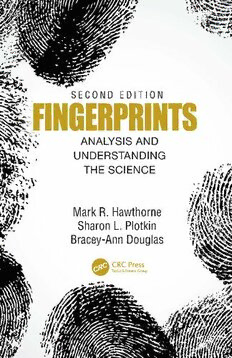Table Of ContentFINGERPRINTS
FINGERPRINTS
ANALYSIS
AND
UNDERSTANDING THE
SCIENCE
MARK R. HAWTHORNE
SHARON L. PLOTKIN
BRACEY-ANN DOUGLAS
Second edition published 2021
by CRC Press
6000 Broken Sound Parkway NW, Suite 300, Boca Raton, FL 33487-2742
and by CRC Press
2 Park Square, Milton Park, Abingdon, Oxon, OX14 4RN
© 2021 Taylor & Francis Group, LLC
First edition published by CRC Press 2009
CRC Press is an imprint of Taylor & Francis Group, LLC
Reasonable efforts have been made to publish reliable data and information,
but the author and publisher cannot assume responsibility for the validity
of all materials or the consequences of their use. The authors and
publishers have attempted to trace the copyright holders of all material
reproduced in this publication and apologize to copyright holders if
permission to publish in this form has not been obtained. If any copyright
material has not been acknowledged please write and let us know so we
may rectify in any future reprint.
Except as permitted under U.S. Copyright Law, no part of this book may be
reprinted, reproduced, transmitted, or utilized in any form by any
electronic, mechanical, or other means, now known or hereafter invented,
including photocopying, microfilming, and recording, or in any information
storage or retrieval system, without written permission from the publishers.
For permission to photocopy or use material electronically from this work,
access www.copyright.com or contact the Copyright Clearance Center, Inc.
(CCC), 222 Rosewood Drive, Danvers, MA 01923, 978-750-8400. For works
that are not available on CCC please contact mpkbookspermissions@tandf.
co.uk
Trademark notice: Product or corporate names may be trademarks or
registered trademarks and are used only for identification and explanation
without intent to infringe.
Library of Congress Cataloging‑in‑Publication Data
ISBN: 978-0-367-47950-3 (hbk)
ISBN: 978-0-367-47951-0 (pbk)
ISBN: 978-1-003-03736-1 (ebk)
Typeset in Minion
by MPS Limited, Dehradun
Contents
Preface.....................................................................................................................ix
Acknowledgments.................................................................................................xi
About the Authors.............................................................................................xiii
Part I: Fingerprint Analysis
1
The History of Fingerprints.............................................................3
Outline of the History of Fingerprints..............................................................4
Early Cases Resulting in the Acceptance of Fingerprints......................9
Early Nonsystematic Methods of Identification............................................11
Chapter 1 Study Questions................................................................................13
2
Systematic Methods of Identification.........................................15
Bertillonage............................................................................................................16
Fingerprints...........................................................................................................20
Definitions Associated with Fingerprints.................................................20
Fingerprint Patterns and Ridge Characteristics......................................24
More Fingerprint Definitions.....................................................................25
Chapter 2 Study Questions................................................................................27
3
Fingerprint Pattern Types and Associated
Terminology......................................................................................29
Loop Pattern.........................................................................................................29
Loop Ridge Counting..........................................................................................34
Radial and Ulnar Loops......................................................................................35
Other Issues Pertaining to Loops.....................................................................36
Plain Arch and Tented Arch Patterns.............................................................39
The Plain Arch..............................................................................................39
The Tented Arch..........................................................................................39
The Whorl Pattern...............................................................................................41
Plain Whorl...................................................................................................43
Central Pocket Loop Whorl.......................................................................44
Double Loop Whorl.....................................................................................50
v
vi Contents
Accidental Whorl..........................................................................................52
Ridge Tracing and Counting Whorl Patterns................................................54
The Palm Print.....................................................................................................55
Chapter 3 Study Questions................................................................................57
4
Introduction
to Classification Systems................................................................59
Henry with FBI Extension.................................................................................59
Ridge Count Conversion....................................................................................66
Conversion Chart for Ridge Counts................................................................66
Referencing............................................................................................................70
Filing Sequence.....................................................................................................71
NCIC Classification System...............................................................................72
IAFIS......................................................................................................................73
Other Fingerprint Systems (Manual Methods or Systems).........................74
Chapter 4 Study Questions................................................................................75
Part II: Development, Identification, and Presentation
of Fingerprints
5
Known/Direct/Inked Fingerprints: Processing Technique for
Unknown/Latent Fingerprints......................................................79
Known Fingerprints.............................................................................................79
Manual Method....................................................................................................79
Live Scan................................................................................................................88
Unknown Fingerprints (Commonly Referred to as Latent Prints)............89
Conditions Affecting Latent Prints...................................................................90
The Crime Scene Search and Fingerprint Development..............................91
Fingerprint Development Techniques.............................................................93
Powder Techniques......................................................................................94
Chemical Techniques.................................................................................104
Ardrox Dye Stain—Aqueous Premix......................................................120
Basic Yellow 40 Dye Stain........................................................................120
Fingerprint Comparison and Identification..................................................131
Chapter 5 Study Questions..............................................................................143
6
Court Preparation and Presentation........................................145
Preparation of the Exhibit................................................................................145
Courtroom Etiquette.........................................................................................147
Qualifying the Expert Witness........................................................................147
Contents vii
Courtroom Testimony......................................................................................148
Presentation of the Exhibit..............................................................................149
The historic case that allowed fingerprint evidence in the courtroom...149
Review..................................................................................................................149
Challenges to the Science of Fingerprints.....................................................151
Federal Rules of Evidence Rule 702...............................................................152
Chapter 6 Study Questions..............................................................................153
Appendix A.............................................................................................155
Appendix B.............................................................................................159
Appendix C.............................................................................................163
Bibliography............................................................................................167
Glossary...................................................................................................169
Index........................................................................................................173
Preface
Friction skin and fingerprints have long been considered the parts of the
anatomy that serve a specific purpose. Since the beginning of mankind,
observations of friction skin on the inner hands and bottoms of the feet
have given observers something to think about as these particular areas
have an appearance significantly different from other parts of the skin.
Since the beginning, the purpose of friction skin has been explored. As
time evolved and the degree of sophistication and education increased, the
purpose and the uses of friction skin were slowly discovered by those early
pioneers who took it upon themselves to research its varied uses. It soon
became quite evident that friction skin had more uses than simply
utilitarian. As the uniqueness of the composition of friction skin was
discovered, it was determined and could be used to identify individuals. The
recognition of the different uses of friction skin, and specifically
fingerprints, did not occur in a vacuum or overnight. It has only been
within the past three to four hundred years, a time in which technology has
allowed such research, that the true marvel uses of friction skin, and
specifically fingerprints, have come to the forefront. Since that time, many
issues surrounding fingerprints and footprints have become part of the
evolution of fingerprint science. Some would argue that the study of
fingerprints is not truly a science, but strictly an art.
The study of fingerprints is akin to any other science. There are sets of
assumptions that must be proved or disproved. As with other sciences, the
science of fingerprint study, has grown by leaps and bounds over the past
one hundred years. Various techniques and research that have been
undertaken serve only to strengthen the position of the science. However,
we must ask ourselves what must be done to maintain the integrity of the
science of fingerprints? What is needed is an educational process, guidelines
and protocols to train practitioners, both advocates and critics alike, in the
strengths and weaknesses of fingerprints as a form of identification, whether
in the field or in the courtroom, and recognition to those who work in
the field of latent processing of fingerprints with a need for a basic
understanding of the applications.
The National Academy of Sciences (NAS) report in 2009 was
established to guarantee that continued improvements will support law
enforcement officials in the work responsibilities during investigations to
identify offenders with higher reliability. This report examines forensic
ix

